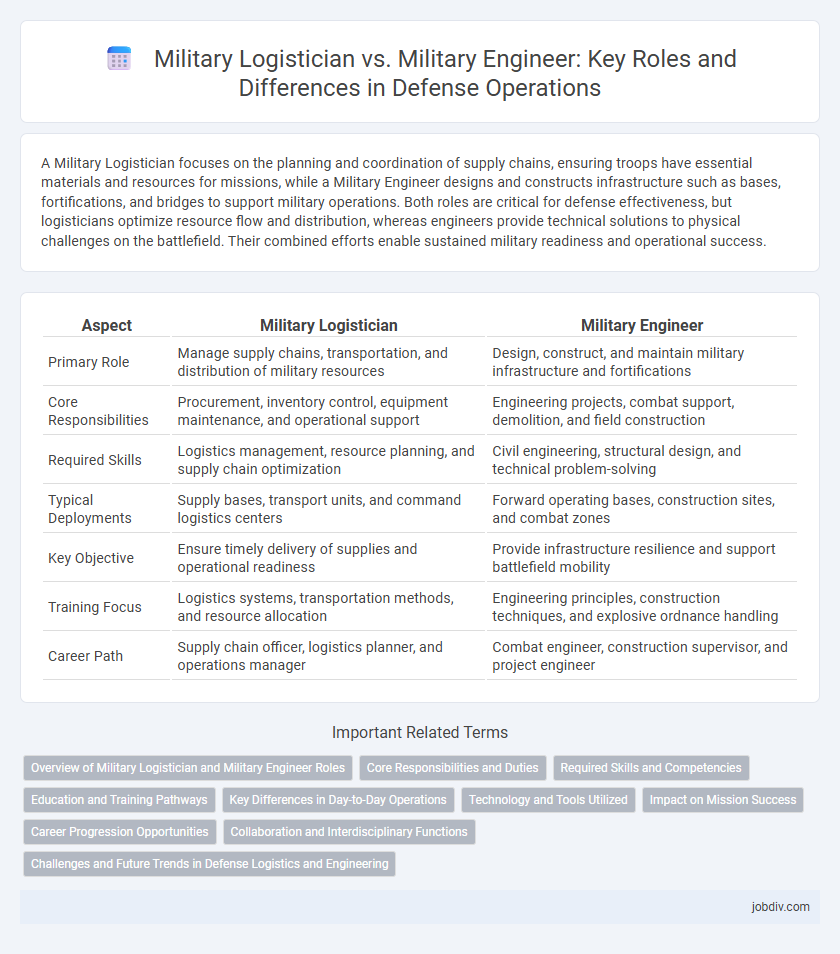A Military Logistician focuses on the planning and coordination of supply chains, ensuring troops have essential materials and resources for missions, while a Military Engineer designs and constructs infrastructure such as bases, fortifications, and bridges to support military operations. Both roles are critical for defense effectiveness, but logisticians optimize resource flow and distribution, whereas engineers provide technical solutions to physical challenges on the battlefield. Their combined efforts enable sustained military readiness and operational success.
Table of Comparison
| Aspect | Military Logistician | Military Engineer |
|---|---|---|
| Primary Role | Manage supply chains, transportation, and distribution of military resources | Design, construct, and maintain military infrastructure and fortifications |
| Core Responsibilities | Procurement, inventory control, equipment maintenance, and operational support | Engineering projects, combat support, demolition, and field construction |
| Required Skills | Logistics management, resource planning, and supply chain optimization | Civil engineering, structural design, and technical problem-solving |
| Typical Deployments | Supply bases, transport units, and command logistics centers | Forward operating bases, construction sites, and combat zones |
| Key Objective | Ensure timely delivery of supplies and operational readiness | Provide infrastructure resilience and support battlefield mobility |
| Training Focus | Logistics systems, transportation methods, and resource allocation | Engineering principles, construction techniques, and explosive ordnance handling |
| Career Path | Supply chain officer, logistics planner, and operations manager | Combat engineer, construction supervisor, and project engineer |
Overview of Military Logistician and Military Engineer Roles
Military logisticians coordinate the acquisition, distribution, and maintenance of supplies, equipment, and personnel essential for operational readiness and mission success. Military engineers design, construct, and maintain infrastructure, including fortifications, roads, and bridges, while also providing technical expertise in combat and non-combat operations. Both roles are critical in ensuring effective military operations, with logisticians focusing on resource management and engineers addressing structural and tactical challenges.
Core Responsibilities and Duties
Military logisticians coordinate the procurement, distribution, and maintenance of equipment, supplies, and personnel to ensure operational readiness and effective mission support. Military engineers design, construct, and maintain military infrastructure such as fortifications, airfields, and bridges, enhancing the mobility and survivability of armed forces. Both roles are critical for sustaining military operations, with logisticians focusing on resource management and engineers on technical infrastructure development.
Required Skills and Competencies
Military logisticians require expertise in supply chain management, inventory control, and transportation coordination to ensure timely delivery of resources in operational environments. Military engineers must possess strong skills in project management, structural analysis, and technical problem-solving to design, construct, and maintain military infrastructure and equipment. Both roles demand proficiency in strategic planning, communication, and adaptability to support mission readiness and operational efficiency.
Education and Training Pathways
Military logisticians typically pursue education in supply chain management, operations, or business administration, often obtaining certifications such as Certified Logistics Technician (CLT) or attending military-specific courses like the Army Logistics University programs. Military engineers generally follow engineering degree programs in fields such as civil, mechanical, or electrical engineering, supplemented by specialized military training including combat engineering and engineering officer candidate schools. Both career paths require rigorous physical training and leadership development, but engineers focus heavily on technical problem-solving skills while logisticians emphasize strategic resource management and coordination.
Key Differences in Day-to-Day Operations
Military logisticians focus on the planning, coordination, and management of supply chains, ensuring troops receive necessary equipment, food, and ammunition efficiently. Military engineers concentrate on constructing and maintaining infrastructure such as bridges, fortifications, and roads, directly supporting operational mobility and battlefield readiness. While logisticians optimize resource flow and distribution, engineers solve technical challenges related to terrain and facility construction in combat zones.
Technology and Tools Utilized
Military logisticians leverage advanced supply chain management software, GPS tracking systems, and automated inventory control tools to efficiently coordinate the movement of troops and materials. Military engineers employ sophisticated technologies such as computer-aided design (CAD) software, remote sensing devices, and robotic construction equipment for infrastructure development and battlefield fortification. Both roles integrate cutting-edge communication systems and cybersecurity measures to enhance operational effectiveness in modern defense environments.
Impact on Mission Success
Military logisticians ensure the seamless supply and distribution of resources, directly influencing operational readiness and mission endurance. Military engineers design and maintain infrastructure, fortifications, and equipment essential for tactical advantage and force protection. Together, their specialized roles synergize to optimize mission success through efficient resource management and battlefield adaptability.
Career Progression Opportunities
Military logisticians advance through ranks by mastering supply chain management, transportation coordination, and resource allocation critical for operational success. Military engineers progress by developing expertise in construction, fortification, and infrastructure repair, with opportunities to lead engineering units or oversee large-scale projects. Both career paths offer leadership roles and specialized skill development, but military engineers often transition into technical or project management positions within defense infrastructure.
Collaboration and Interdisciplinary Functions
Military logisticians and military engineers collaborate closely to optimize operational efficiency by integrating supply chain management with infrastructure development. Their interdisciplinary functions include coordinating resources, managing transportation, and ensuring the construction and maintenance of essential facilities to support combat and humanitarian missions. Effective collaboration between these roles enhances mission readiness and sustains prolonged military engagements through seamless support systems.
Challenges and Future Trends in Defense Logistics and Engineering
Military logisticians face the challenge of ensuring seamless supply chain management amid rapidly evolving battlefield environments and increasing reliance on advanced technology. Military engineers must address infrastructure resilience and the integration of cutting-edge systems like autonomous vehicles and smart materials to enhance operational efficiency. Future trends emphasize the convergence of AI-driven logistics platforms and modular engineering solutions to adapt swiftly to dynamic defense demands.
Military Logistician vs Military Engineer Infographic

 jobdiv.com
jobdiv.com